We have been discussing the importance of evaluating the right heart over the past few blogs this month. The ASE updated the chamber quantification guidelines that provided us with the correct methods to measuring size and function of the right ventricle (RV) and atrium (RA). This week, we are going to talk about the proper method to measuring the size of the right atrium! We will review both the preferred volumetric measurement methods and the linear measurements of the right atrium.
The ASE suggests measuring the RA size in the Standard AP4 window. This view allows us to image the atrium at it’s widest diameter, at end-systole.
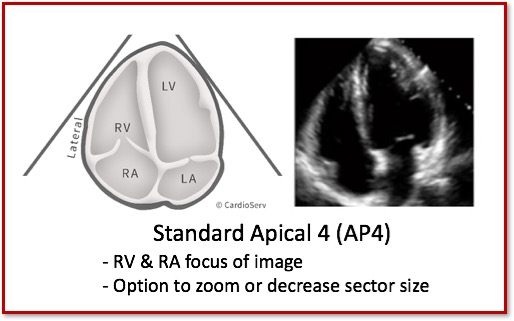
The ASE explains two methods for measuring the size of the RA:
The recommendation for quantifying the size of the right atrium is to measure the right atrial volume. The benefits to performing RA volume over linear measurements is:
In the case where you do not have full visualization to perform RA volume, then linear measurements are a good alternative method.
This measurement is performed from a single-plane image using either the area-length or disk summation technique. Select which method (calculation) you will use on your ultrasound system. We personally prefer the disk summation technique. With either method:
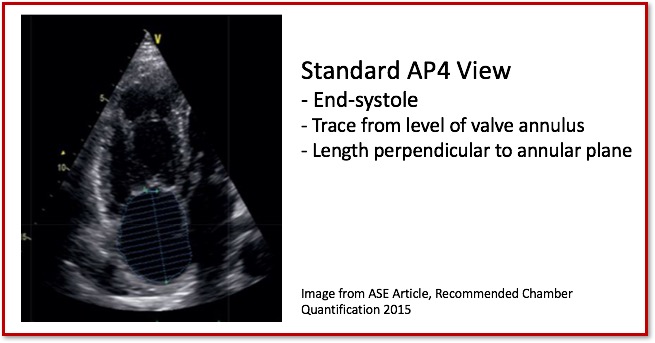
With the updated ASE guidelines, they explained that gender plays a key role when determining the abnormal values of the RA size. Remember the referenced values provided for RA volume are:
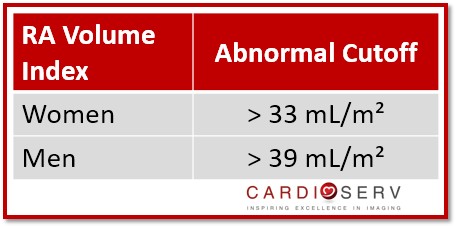
As we all know that the heart is not a single-dimension structure. Research and technological advancement in ultrasound has allowed echo to move from linear measurements to preferred volumetric methods of evaluating heart structures. With that said, if you cannot fully see the RA border properly trace than linear measurements are the next option for providing a measurement.
The updated chamber quantification guidelines provide the two linear measurements to perform, if you are unable to obtain a RA volume.
The two measurements to obtain are the:
How to perform:
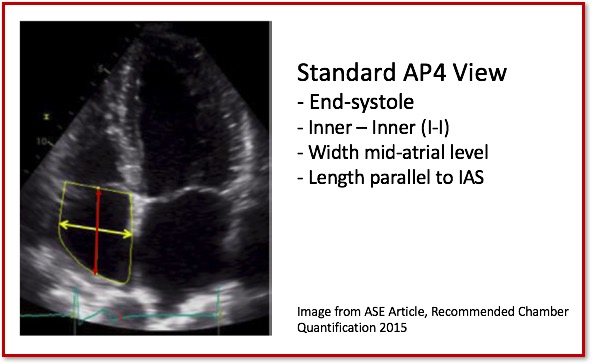
The ASE updated RA dimension ranges are now gender specific and indexed to BSA. This is an update from the previous reference ranges last published in 2010 as the prior guidelines did not have enough data to provide gender specific guidelines and the linear dimensions previously provided were not indexed to BSA.
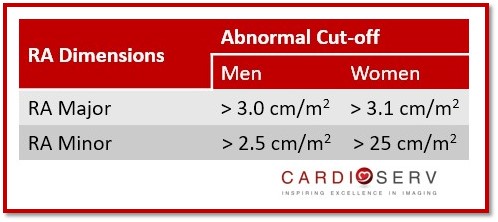
IF your laboratory has older machines and/or do not have the ability to index these linear measurements, as a guide you may choose to use the 2010 ASE RV Guidelines for linear measurement reference values. Here is an easy reference chart to go by in your scanning laboratory:
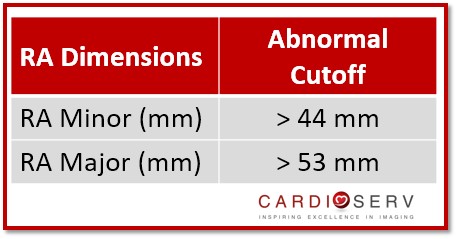
We have had success manually adding indexed volume measurements to US systems for some of our clients. We suggest that you reach out to your ultrasound vendor for help creating an indexed RA volume if this measurement is not readily available.
It is important that when we are performing the methods to quantify the size of the RV and RA, that we play attention to the correct timing of the cardiac cycle when we measure. Remember for the RV, we need to measure at end-diastole (when the RV is at its widest width). When obtaining the volume for RA, it is at end-systole (when the RA has the largest volume).
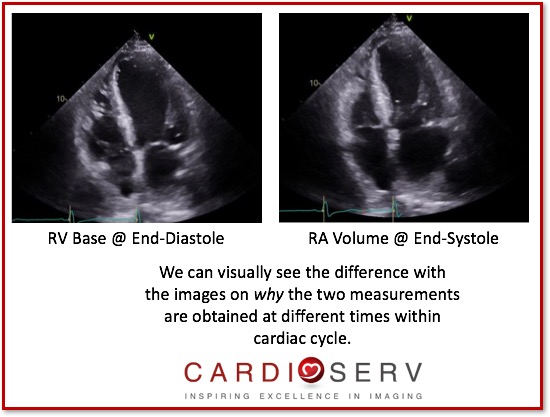
ASE provides great information on how to properly evaluate the ‘forgotten right heart’. Here at CardioServ, we want to help provide you with easy tips to correct quantification techniques. Our goal is for you to add right heart quantification to your routine scanning protocol. Next week, will go further into recommend methods on how to quantify the systolic function of the RV via TAPSE and S’ Wave. We love your comments, feedback and questions! Please keep them coming and stay connected with us on Facebook, Twitter and LinkedIn!

Andrea Fields MHA, RDCS, Cardiac Clinical Director
Lang, R. M., MD, Badano, L. P., MD, & Mor-Avi, V., PhD. (2015). Recommendations for Cardiac Chamber Quantification by Echocardiography in Adults: An Update from the American Society of Echocardiography and the European Association of Cardiovascular Imaging. JASE, 28(1), 1-53. Retrieved March 1, 2017, from http://asecho.org/wordpress/wp-content/uploads/2015/01/ChamberQuantification2015.pdf




Apr
2017
May
2017
Apr
2017
Apr
2017
May
2017
May
2017
May
2017
May
2017
May
2017
May
2017
May
2017
May
2017